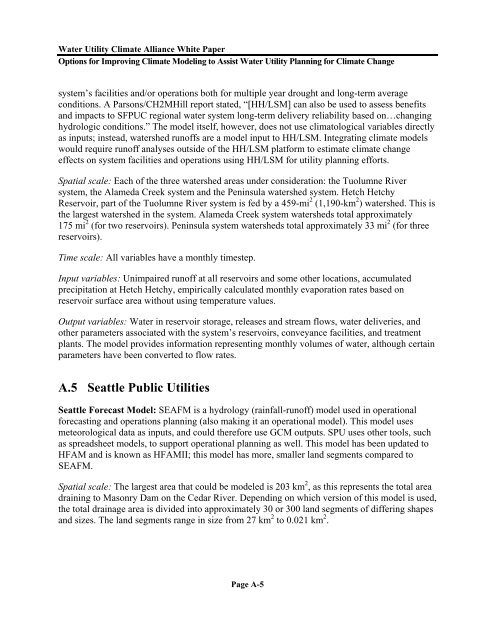Options for Improving Climate Modeling to Assist Water Utility ...
Options for Improving Climate Modeling to Assist Water Utility ...
Options for Improving Climate Modeling to Assist Water Utility ...
Create successful ePaper yourself
Turn your PDF publications into a flip-book with our unique Google optimized e-Paper software.
<strong>Water</strong> <strong>Utility</strong> <strong>Climate</strong> Alliance White Paper<br />
<strong>Options</strong> <strong>for</strong> <strong>Improving</strong> <strong>Climate</strong> <strong>Modeling</strong> <strong>to</strong> <strong>Assist</strong> <strong>Water</strong> <strong>Utility</strong> Planning <strong>for</strong> <strong>Climate</strong> Change<br />
system’s facilities and/or operations both <strong>for</strong> multiple year drought and long-term average<br />
conditions. A Parsons/CH2MHill report stated, “[HH/LSM] can also be used <strong>to</strong> assess benefits<br />
and impacts <strong>to</strong> SFPUC regional water system long-term delivery reliability based on…changing<br />
hydrologic conditions.” The model itself, however, does not use clima<strong>to</strong>logical variables directly<br />
as inputs; instead, watershed runoffs are a model input <strong>to</strong> HH/LSM. Integrating climate models<br />
would require runoff analyses outside of the HH/LSM plat<strong>for</strong>m <strong>to</strong> estimate climate change<br />
effects on system facilities and operations using HH/LSM <strong>for</strong> utility planning ef<strong>for</strong>ts.<br />
Spatial scale: Each of the three watershed areas under consideration: the Tuolumne River<br />
system, the Alameda Creek system and the Peninsula watershed system. Hetch Hetchy<br />
Reservoir, part of the Tuolumne River system is fed by a 459-mi 2 (1,190-km 2 ) watershed. This is<br />
the largest watershed in the system. Alameda Creek system watersheds <strong>to</strong>tal approximately<br />
175 mi 2 (<strong>for</strong> two reservoirs). Peninsula system watersheds <strong>to</strong>tal approximately 33 mi 2 (<strong>for</strong> three<br />
reservoirs).<br />
Time scale: All variables have a monthly timestep.<br />
Input variables: Unimpaired runoff at all reservoirs and some other locations, accumulated<br />
precipitation at Hetch Hetchy, empirically calculated monthly evaporation rates based on<br />
reservoir surface area without using temperature values.<br />
Output variables: <strong>Water</strong> in reservoir s<strong>to</strong>rage, releases and stream flows, water deliveries, and<br />
other parameters associated with the system’s reservoirs, conveyance facilities, and treatment<br />
plants. The model provides in<strong>for</strong>mation representing monthly volumes of water, although certain<br />
parameters have been converted <strong>to</strong> flow rates.<br />
A.5 Seattle Public Utilities<br />
Seattle Forecast Model: SEAFM is a hydrology (rainfall-runoff) model used in operational<br />
<strong>for</strong>ecasting and operations planning (also making it an operational model). This model uses<br />
meteorological data as inputs, and could there<strong>for</strong>e use GCM outputs. SPU uses other <strong>to</strong>ols, such<br />
as spreadsheet models, <strong>to</strong> support operational planning as well. This model has been updated <strong>to</strong><br />
HFAM and is known as HFAMII; this model has more, smaller land segments compared <strong>to</strong><br />
SEAFM.<br />
Spatial scale: The largest area that could be modeled is 203 km 2 , as this represents the <strong>to</strong>tal area<br />
draining <strong>to</strong> Masonry Dam on the Cedar River. Depending on which version of this model is used,<br />
the <strong>to</strong>tal drainage area is divided in<strong>to</strong> approximately 30 or 300 land segments of differing shapes<br />
and sizes. The land segments range in size from 27 km 2 <strong>to</strong> 0.021 km 2 .<br />
Page A-5

















